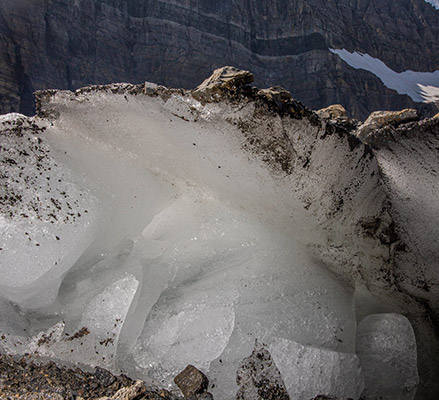Last updated: September 15, 2023
Lesson Plan
Breaking it Down

- Grade Level:
- Middle School: Sixth Grade through Eighth Grade
- Subject:
- Science
- Lesson Duration:
- 60 Minutes
Essential Question
What impact does a glacier have on rock?
Objective
Students will:
• Infer what will happen if a jar filled with water is put in the freezer overnight.
• Observe that as water freezes, it changes form, expands and produces force.
• Relate how water expanding when it freezes, weathers rocks.
• Identify moving ice as the primary component of a glacier.
Background
Read pages 49-52 in the Work House Program Unit 3: Climate Changes; Glaciers and Glaciation.
This lesson is one unit of the Work House: A Glacier National Park Science and Indian Education Program. It can be completed as a stand alone lesson or as part of the greater Work House course.
The full Work House Program is available on Glacier National Park's website.
Additional background information as well as the full lesson plan can be found as a PDF here.
Preparation
- This activity is designed to have students think about the power of water as it changes from liquid to a solid state when it freezes and expands. Teacher must get access to freezer, students bring jars from home or teacher provides. Make sure you have safety guidelines in place for dealing with broken glass!
- Student Reading Unit 3
- Access to a freezer
- A tray
- A glass bottle or jar with a tight lid (thin glass on the jar, may help dramatize the demonstration)
Procedure
- Have students complete the Student Reading, Unit 3 (page 122 of the Work House Program)- individually, in groups, or together as a class and complete the “Checking for Understanding Questions.” Discuss vocabulary and any new concepts. You may want to show this video about the unique geology of Glacier National Park and discuss how the glacially carved valleys of Glacier National Park are what give the park its name. Also, how the vastness of these valleys is one of the park’s most awe-inspiring features to many visitors. Review some of the words from the Blackfeet, Kootenai, Pend d’Oreille and Salish about their connection to these mountains and valleys.
- Tell students you are going to do a short experiment to try to find out how water could break rock. This can be done as a demonstration, or each team could bring in an unneeded, thin glass jar from home. Have teams make sure to label their jars. Fill each jar with water to the point where there is no room for air in the jar, then close the jar tightly.
- Place the filled jar(s) on a tray and have someone place it in a deep freeze.
- The next time the class meets to work with glaciers, have someone bring the tray with the jar(s) carefully back to the classroom. Note what happened to the jars. The jar lid should be bulged out and the glass should be cracked. If not all the jars cracked, try to figure out why -lid not tight enough, not enough water, glass too strong and thick.
Writing Extension
-
Students can research different national parks, some that have glaciers and some that don’t. Have groups of students work together in presenting the information from the different national parks to the class. Compare and contrast the parks that have glaciers currently, with those that don’t. Make a list of what features can be found in both. Students can email, research on line at www.nps.gov for each park, or write to the different parks to get more information for this discussion.
Field Trip Extensions
- Ranger-Led Field Trips and Service Learning Projects in Glacier National Park. Earth Science and Forest Processes field trips about park geology.
- Self-Guided Field Trips as well as Guided Tours - various concession operated - in Glacier National Park.
- Glacier Institute - geology and other education programs.
- Guided Tours in Glacier National Park- various concession operated.
Vocabulary
Bergschrund, expand, freeze, glacier, ice patch, thaw.
Assessment Materials
Reflection and AssessmentHave students make careful observations -but NOT touch their jars. Let the tray sit in a safe place and have them make more observations throughout the day of what happens as the ice melts. How did the shape of the jar change once all the ice was melted? (The glass collapsed in a heap.) Have they ever seen a similar phenomena happen in nature with snow/ice? (This is what actually happens when glacial melt water seeps into headwall rocks and freezes. When the bergschrund gap moves slightly away from the headwall and melting occurs, the surface rocks of the headwall collapse onto the glacier. ) The description of the work of glaciers in the student reading mentioned how melt water in a glacier seeps into cracks in rocks and then expands and breaks up the rocks. Erosion of rock by ice expansion is most dramatic near a glacier headwall, but the process takes place anywhere that ice accumulates in the winter and thaws in the summer.
Additional Resources
- Climate Change Resource Guide- includes Facing the Future Lessons.
- Glacier NP Teacher Cultural Resource Guide - Fact Sheets, Digital Images, Lessons.
- USGS Repeat Photography Project and Repeat Photo Education Trunk.
- Ice Patch Archaeology Resource Brief
- Glacier National Park Ice Patch Project Interactive Website with Kids Page - Confederated Salish and Kootenai Tribes of the Flathead Reservation, the Blackfeet Nation, the Univ. of Wyoming, Univ. of Colorado Boulder, Univ. of Arizona, Glacier National Park’s cultural resources program and the Rocky Mountains Cooperative Ecosystem Studies Unit (CESU).
- Flathead Community of Resource Educators Website - contains a resource link to the Flathead Watershed Sourcebook - which contains cultural and natural history of the Flathead watershed.
- Glacier National Park Conservancy Bookstores - books specific to Glacier.
